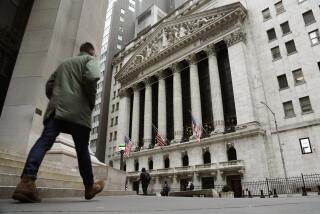THE ECONOMY : Wholesale Inflation Surges 0.7%
- Share via
WASHINGTON — Prices for finished goods spurted 0.7% in December, the Labor Department reported Friday, as cold weather shortages of fuel oil, natural gas and some foodstuffs drove wholesale price inflation to 4.8% for all of 1989.
But unusually weak holiday season retail sales and other indicators showed that the economy continued to slow late in the year, and analysts were generally confident that the unexpectedly large gain in the producer price index was mostly a seasonal phenomenon.
In a separate report, the Commerce Department said retail sales inched up a mere 0.2% in December and rose only 5% for the entire year, the weakest showing since an anemic 2.9% gain in the recession year of 1982.
The combination of slowing consumption and higher wholesale prices was viewed with alarm on Wall Street. The Dow Jones industrial average plummeted more than 50 points by mid-morning, tried without success to rally, and ended the day down 71.46 points.
Yet despite the ominous reminder of 1970s-style stagflation--slumping growth plus accelerating inflation--economists generally agreed that the inflation outlook was not as dismal as the producer price index seemed to indicate.
The gain was attributable in part to seasonal factors, as unusually cold weather pushed up home heating oil prices in December by 7.1%, natural gas by 1.6%, and overall energy costs by 1.4%. Bad weather also caused food prices to jump 0.5% for the month.
But the so-called core rate of wholesale inflation, which excludes highly volatile energy and food prices, rose a discouraging 0.6% in December, compared to gains of 0.1% and 0.2% during the two previous months.
Even so, Bureau of Labor Statistics specialists said another one-time distortion had worked its way into the mix last month. Prices for wholesale tobacco products, which had been rising steadily all year long, spurted 4.5% in December alone.
If the core rate of wholesale inflation were recalculated to exclude tobacco products as well as food and energy, BLS statistician Andrew Clem said, the monthly gain would have been reduced to just 0.1% last month.
Indeed, December’s slow retail sales and subsequent indications of widespread merchandise sales and rebates by retailers suggested that higher wholesale prices will not easily be passed along to consumers.
“The (stock) markets overreacted,” said Lynn Reaser, an economist with First Interstate Bancorp in Los Angeles.
Reaser noted that the increases in food and energy were weather-related and likely to be temporary. In addition, he said, there usually is a sizable increase in non-food, non-energy producer prices in December, despite Labor Department efforts to adjust the figures for seasonal fluctuations.
“We need to put these increases into perspective,” Reaser said. “With the economy growing at a fairly slow pace, it is simply wrong to draw from this the conclusion that inflation is now rising at 8% a year.”
Last year’s 4.8% increase in wholesale prices compared to 4% the year before. With energy and food excluded, wholesale inflation last year was 4.2%, compared to 4.3% in 1988.
“We think we are going to see a bubble for both food and energy because of the cold weather,” said Stacy Kottman of the economic forecasting project at Georgia State University in Atlanta.
Kottman predicted higher food and energy prices again for January, as gasoline and produce prices continue December’s cold weather surge.
But energy specialists already have predicted price drops later on, and Kottman noted that the lingering effects of the 1988 drought that pushed up food prices last year have by now worked their way through the system.
Allen Sinai, an economist with the Boston Co., said the wholesale price increases in December are significant only when seen against the backdrop of weak Christmas-season retail sales.
Among other things, the year-end sales statistics showed a steep 0.6% drop in sales of big-ticket, higher-priced durable goods, while sales of non-durables, which include clothing as well as foodstuffs, rose 0.6%.
“The retail report is further evidence that consumers will only buy when prices are cut,” Sinai said, noting that all big-ticket sales were down.
“So against that backdrop of weakness, the surge in producer prices was only a blip and should be temporary,” he said. “The message of the retail report is that the consumer is hard put to spend, and we know that the manufacturing sector is already near recession. We are unlikely to have price increases that are other than weather-related.”
Sinai said inflation for capital goods in the producer price index remained moderate at 0.2% for the month and was up only 3.7% for 1989 despite much higher increases early in the year.
Among intermediate and crude goods, December prices for industrial materials were down 1.6% for durables and 0.4% for non-durables, while prices for all intermediate goods fell 0.1% and for crude goods rose 1.8%. Again excluding food and energy, intermediate goods prices fell 0.4% and crude goods prices fell 1.8%.
Before seasonal adjustment, the price movements for finished goods in December left the producer price index at 115.3, compared to 114.8 in November and a 1982 base of 100. That means a hypothetical market basket of goods that cost $100 in 1982 and $114.80 in November cost $115.30 at wholesale last month.
PRODUCER PRICE INDEX
Seasonally adjusted change from previous month Dec., ‘89: +0.7% Nov., ‘89: -0.1% Dec., ‘88: +0.4% Source: Labor Department
More to Read
Inside the business of entertainment
The Wide Shot brings you news, analysis and insights on everything from streaming wars to production — and what it all means for the future.
You may occasionally receive promotional content from the Los Angeles Times.










